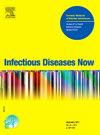早期suPAR水平作为COVID-19严重程度的预测指标:一种高效患者分诊的新工具
IF 2.2
4区 医学
Q2 INFECTIOUS DISEASES
引用次数: 0
摘要
在经历了几波COVID-19大流行之后,我们现在面临着较低但持续的SARS-CoV-2感染率,季节性复发往往与其他呼吸道感染同时发生。目的:我们旨在确定可预测原发性SARS-CoV-2感染患者不良结局的早期临床生物学变量。我们还评估了suPAR(一种创新的生物标志物)在预测疾病严重程度中的作用。方法纳入255例经pcr确诊的原发性SARS-CoV-2感染患者,随访时间至少为30天。在住院前24小时内采集血样以测量suPAR水平。对医疗记录的综合数据进行分析,以评估其在将患者分为七个严重程度组中的预测价值,其中1至3组代表严重的COVID-19(死亡、插管、ECMO或无创通气)。ANOVA和logistic回归模型证明,早期血浆suPAR水平与严重疾病进展显著相关,表明suPAR是不利结果的持续预测因素。结论:我们的研究结果表明,在SARS-CoV-2 PCR检测阳性后早期进行单次suPAR测量对患者预后具有很强的预测价值。这种生物标志物与脉搏血氧仪和CT扫描结果一起,可能有助于在COVID-19季节性复发期间对患者进行早期分诊。本文章由计算机程序翻译,如有差异,请以英文原文为准。
Early suPAR levels as a predictor of COVID-19 severity: A new tool for efficient patient triage
Background
Following several waves of the COVID-19 pandemic, we are now facing a lower but persistent rate of SARS-CoV-2 infections, with seasonal resurgences often coinciding with other respiratory tract infections.
Objective
We aimed to identify early clinico-biological variables predictive of an unfavorable outcome in patients with primary SARS-CoV-2 infection. We also evaluated the role of suPAR, an innovative biomarker, in predicting disease severity.
Methods
We included 255 patients with PCR-confirmed primary SARS-CoV-2 infection and with a 30-day follow-up minimum. Blood samples were collected within the first 24 h of hospitalization to measure suPAR levels. Comprehensive data from medical records were analyzed to assess their predictive value in stratifying patients into seven severity groups, with groups 1 to 3 representing severe COVID-19 (death, intubation, ECMO, or non-invasive ventilation).
Results
Early plasma suPAR levels were significantly associated with severe disease progression, as evidenced by ANOVA and logistic regression models, highlighting suPAR as a persistent predictive factor for unfavorable outcomes.
Conclusion
Our findings suggest that a single suPAR measurement, performed early after a positive PCR test for SARS-CoV-2, holds strong predictive value for patient outcomes. This biomarker, alongside pulse oximetry and CT scan results, could be instrumental in early patient triage during seasonal COVID-19 resurgences.
求助全文
通过发布文献求助,成功后即可免费获取论文全文。
去求助
来源期刊

Infectious diseases now
Medicine-Infectious Diseases
CiteScore
7.10
自引率
2.90%
发文量
116
审稿时长
40 days
 求助内容:
求助内容: 应助结果提醒方式:
应助结果提醒方式:


